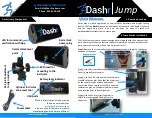
We strongly recommend a registered electrician installs this light fitting.
Warning: Isolate the power supply before installation.
• Release the front fascia of the light, by inserting a flat head screwdriver into the two tabs at the base of the
fitting and gently turn these. Remove the front facia.
• Unscrew and remove the small connection cover on the front of the fitting.
• Position the unit against wall in the desired location, ensuring the power supply cable can easily enter the
fitting through the rubber grommet at the rear of the fitting.
• Use the holes in each corner of the fitting to mark the 4 drill holes required to secure the base to the wall
(and mark the cable inlet location if required).
• Drill the wall and fit the wall plugs supplied.
• Use a sharp knife to cut a small ‘X’ in the rubber grommet and feed the power supply cable through into
the light fitting. Note: Please ensure the cable enters the grommet from beneath to avoid moisture migration.
• The light fitting can now be fixed to the wall using the mounting screws provided.
• Strip cable insulation 6mm and attach to the terminal block following the label denotations.
• After the wiring is secured, the PIR controls should be set and tested, as described in ‘DAYTIME Walk
Test’ on the following page.
• Once this is done, and changes are no longer required, replace the small connection cover securely, and
refit the front fascia, using the double-sided tape (supplied) between the fascia and the opal lens for more
permanent fixing.
ELITE LED PIR Bulkhead is a Class 1 fitting and therefore needs to be Earthed for electrical safety.
Waterproof cable should be used for outdoor installations. Using Twin and Earth 3 core round flexible cable
at least 1mm² gauge is preferred.
Avoid directing the PIR sensor towards objects that may move in the wind, such as shrubs or trees, or at
highly reflective surfaces. Avoid positioning the light fitting near heat sources, such as hot ventilator ducts,
air conditioning units, exhaust outlets, street lighting or traffic, all of which may interfere with PIR operation.
Note that a PIR sensor is more sensitive to a heat source moving across its coverage area, and less sensitive
to a heat source that moves directly towards the PIR.
This PIR operates on P-LUX technology, providing a continuous low level courtesy light from dusk to dawn,
powering up to full light output when presence detection is made. Low level output is max 2 watts.
Once the fitting is electrically connected, it requires approx. 60 sec to warm up. During this time the light will
switch on for a short time then turn itself off. Do not commence any walk tests until this time has elapsed.
Dials on the P-LUX rotate clockwise or anti-clockwise and should be turned GENTLY using a flat head screwdriver.
LUX adjustment
Dial marked ‘L’ sets the acceptable amount of light present before the unit will activate. At the lowest
level it operates only at maximum darkness, at highest level it operates both day and night. Set to desired
activation point depending on the needs of the installation.
TIME adjustment
Dial marked ‘T’ has a minimum setting of approx. 5sec and a maximum setting of approx. 5min. This
adjusts to the preferred duration the light activates for when it last detects movement. The timer will restart
each time the sensor detects any new movement.
RANGE adjustment
Dial marked ‘R’ alters the PIR range of detection and the amount of infra-red radiation (heat) required to
trigger the PIR. To be effective but keep nuisance tripping to a minimum, it is advised to turn the range
control to the middle position where the ambient temperature is between 15⁰-20⁰C. This range sensitivity
adjustment can also be used to compensate for changes in outside air temperature in Winter (set lower)
and Summer (set higher).
For DAYTIME walk testing:
Turn the TIME dial marked ‘T’ fully anti-clockwise to minimum setting, and the LUX control dial marked ‘L’
fully clockwise to maximum setting. Turn on the power to the light.
The light should light up for approx. 15 sec then dim down until the PIR is activated again, when it will again
revert to full power.
Use this setting for walk testing the unit to understand the detection zone, and adjust the RANGE control
marked ‘R’ to suit your location. Once this is set, readjust TIME and LUX to suit your needs, then reassemble
the fitting.
Care and consideration should be taken when this unit is located close to property boundaries, to avoid
unnecessary spill light or glare to neighbours, and to avoid unwanted activation of the PIR by passing
pedestrians or vehicles.
ELECTRICAL INSTALLATION
INSTALLING YOUR ELITE PIR BULKHEAD
L
N
E
RANGE
TIME
LUX
PIR Setting Controls
SENSOR CALIBRATION




















